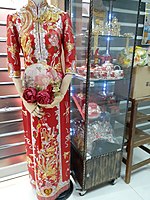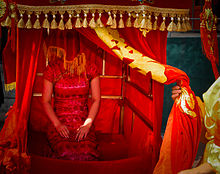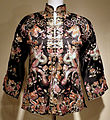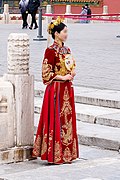Qungua
| Qungua | |||||||||||
|---|---|---|---|---|---|---|---|---|---|---|---|
 Qungua in Hong Kong, 2020 | |||||||||||
| Chinese | 裙褂 | ||||||||||
| Literal meaning | Skirt jacket | ||||||||||
| |||||||||||
Qungua (Chinese: 裙褂; Jyutping: kwan4 gwaa3), also known as longfenggua (simplified Chinese: 龙凤褂; traditional Chinese: 龍鳳褂),[1] or longfeng qungua (simplified Chinese: 龙凤裙褂; traditional Chinese: 龍鳳裙褂),[2] or guaqun (Chinese: 褂裙; Jyutping: gwaa3 kwan4),[3] is one type of two-piece ceremonial traditional Chinese wedding set of attire, which is composed of a jacket called gua (褂) and of a long Chinese skirt called qun (裙). The qungua is a type of Hanfu worn by Han Chinese brides[4] and originated in the 18th century during the Qing dynasty.[1] It eventually became the traditional wedding attire of Cantonese brides in the Guangdong regions.[3][5] It is traditionally handmade and is decorated with dragons and phoenixes embroideries.[6] Nowadays, the qungua is still popular as a wedding dress in China, including in Hong kong and Macau.[1]
Origins and tradition

Back in Ming dynasty, the women wedding dress worn by nobles and commoners was known as fengguan xiapei (Chinese: 凤冠霞帔) composed of the fengguan and xiapei.[3] The wedding dress worn in Ming dynasty continued to influence the wedding dress of the later centuries.[3]
What is known as qungua only started to be worn in the 18th century during the Qing dynasty.[1] The qungua originated in Guangdong when Liang Zhu, a Guangdong Qing dynasty politician, was rewarded with a silk wedding dress embroidered with dragons and phoenixes by the Qing Emperor at the time of his daughter's wedding.[7] This led to the use qungua in the Guangdong area.[7]
In 18th century, Chinese mothers would start to sew the qungua as soon as a daughter was born in the family.[1] The qungua would then be placed as a part of the daughter's bride dowry when she gets married.[1] The qungua follows the ancient traditional system of shangyi xiachang (Chinese: 上衣下裳; upper and lower garment).[3]
Construction and Design
The qungua is composed of two separate garments: a gua (Chinese: 褂; pinyin: guà; Jyutping: gwaa3; lit. 'coat'), which is a Chinese jacket which closes at the front with buttons,[4] and a qun (Chinese: 裙; pinyin: qún; Jyutping: kwan4; lit. 'skirt').[2] The qun worn in the qungua is typically straight in cut.[2] The skirt could be pleated.[8]
Colour
While Western wedding dress tends to be white in colour, Chinese traditional wedding clothing favours the use of red and gold colour.[1]
The gua was originally black in colour while the skirt was originally red in colour.[5]
The gua which is completely red in colour only appeared in the 1960s.[5] Since then the traditional black gua and red qun started to be used for the bride's mother instead of being worn by the brides themselves.[5][3]
-
Bride wearing Qing dynasty qungua.
-
Qungua (left) worn by Chinese brides, 1900s.
-
Qungua is a two-piece garment attire: black gua and red qun.
-
Long skirt qun
-
Red gua
-
Construction of a black gua jacket.
-
Black gua
Embroidery
The qungua is typically embroidered with the Chinese dragons called long (simplified Chinese: 龙; traditional Chinese: 龍) and the Chinese phoenix called feng (simplified Chinese: 凤; traditional Chinese: 鳳).[3] It can also be decorated with other auspicious symbols, such as pomegranate (symbolism for fertility), peony flowers, lotus flowers, bats, goldfish, butterfly and birds.[5]
Nowadays, there are 5 different types of qungua which is named accordingly to the percentage of embroidery covering the dress:[1]
- Xiaowufu (小五福): 30% covered with embroidery,
- Zhongwufu (中五福): 50% covered with embroidery
- Dawufu (大五福): 70% covered with embroidery
- Guahou (褂后): 90% covered with embroidery
- Guahuang (褂皇): 100% covered with embroidery
Derivatives and influences
Betawi Bridal dress
The Betawi bridal dress, partly influenced by Chinese culture and by Indonesian culture, looks similar to the Chinese qungua.[7] Like the qungua, the Betawi bridal dress is a two-piece set of attire which composed of an ankle-length with wider bottom skirt called kun and an upper garment called tuaki.[7] The tuaki is decorated with Chinese auspicious symbols.[7] One difference from the qungua is the use of Betawi Lotus, also known as Betawi pomegranate, a separate ornamental garment which covers the chest and shoulder areas (similar to the yunjian of the Chinese people).[7] The Betawi lotus was used to denote the origins of the Betawi bride, but it was eventually replaced by beads which typically follows the Spanish cherry floral pattern.[7] The kun and tuaki must match in colour.[7]
-
Chinese Bride in Batavia in her wedding dress, 1870. The dress is heavily influenced by Chinese culture but also shows subtle differences.
-
Betawi bride and groom, 2008.
Differences with other garments
Fengguan xiapei
The qungua is different from the fengguan xiapei (Chinese: 凤冠霞帔), another type of Traditional Han Chinese wedding set of attire, which was worn in Ming and Qing dynasties[3] in terms of composition of garments and accessories which the qungua lacks of. The fengguan xiapei is a set of attire which was composed of red mang ao (Chinese: 蟒袄; lit. 'python jacket'), which is a type of Ming dynasty-style round-collar robe decorated with dragons, which was worn by Han Chinese women as a court robe; a xiapei (Chinese: 霞帔), which is a type of long scarf in Ming and a type of stole in Qing dynasty; a mangchu (Chinese: 蟒裙; lit. 'Python skirt'), which is a skirt which can be red or green and is embroidered with dragons and phoenixes on the front and back skirt lapels), and the fengguan, the phoenix coronet.[9] The Wedding attire is sometimes decorated with Chinese cloud collar known as yunjian.[9]
-
Portrait of lady in fengguan xiapei in Qing dynasty,
-
Qing dynasty fengguan xiapei (凤冠霞帔), a yunjian is on top of the attire.
Xiuhefu
The qungua is distinct from another Chinese wedding set of attire called Xiuhefu (simplified Chinese: 秀禾服; traditional Chinese: 繡和服).[1][2] The Xiuhefu typically has an overlapping jacket which closes to the right side (instead of the qungua central closing jacket) which is worn with an A-line skirt (qun) which looks similar to a mamianqun instead of a straight cut skirt.[2] The Xiuhefu is typically embroidered with flowers and birds to symbolize love for whole seasons.[3]
-
A bride in Xiuhefu between Taihedian and Zhonghedian, 2022
-
A bride in Xiuhefu near Xiehemen, 2022
Cheongsam

The qungua is different from the cheongsam which can also be worn as a Traditional Chinese wedding dress.[3] The qungua is a two-piece garment composed of jacket and skirts while the modern cheongsam is currently a one-piece robe.[4] Prior to the 1930s and the 1940s, the cheongsam was also a two-piece set of garment which was composed of a long robe and was worn with a pair of trousers.[4]
See also
References
- ^ a b c d e f g h i "To Have And To Embroider: The "Long Feng Gua" Wedding Tradition | US-China Institute". china.usc.edu. Retrieved 2021-06-04.
- ^ a b c d e JNTT (2020-07-30). "SAME SAME BUT DIFFERENT". The Red Wedding. Retrieved 2021-06-04.
- ^ a b c d e f g h i j Li, Yuling (2019). New meaning in traditional wedding dresses – Xiu He Fu and Long Feng Gua – in contemporary China [Master's Thesis]. Cultural Centre, University of Malaya (masters). pp. i-102.
- ^ a b c d Qiao, Nan; Tan, Yan-rong (2017). "Talk About the Chinese Wedding Dress of Modern Women". 2017 3rd International Conference on Social, Education and Management Engineering (SEME 2017): 299–301.
- ^ a b c d e "Chinese Wedding Traditions: Qun Gua | Hong Kong Wedding Blog". 2016-01-28. Retrieved 2021-06-04.
- ^ "Technique of Making Hong Kong Cheongsam and Kwan Kwa Wedding Costume - Home". www.lcsd.gov.hk. Retrieved 2022-08-17.
- ^ a b c d e f g h Indonesia-Taiwan Relations: Searching for Better Understanding. Prof. Dr. Tirta Nugraha Mursitama, Ph.D., Dr. Shidarta, M.Hum., Dr. Yi Ying, M.Lit., M.Pd. Penerbit Andi. 2021. pp. 52–63. ISBN 9786230112744.
{{cite book}}: CS1 maint: others (link) - ^ "Chinese Wedding Gown (Qun Gua)". Queensland Museum Collections Online. Retrieved 2021-06-04.
- ^ a b Garrett, Valery M. (2007). Chinese dress : from the Qing Dynasty to the Present. Tokyo: Tuttle Pub. ISBN 978-0-8048-3663-0. OCLC 154701513.
- CS1 maint: others
- Articles with short description
- Short description is different from Wikidata
- Articles containing Chinese-language text
- Articles containing simplified Chinese-language text
- Articles containing traditional Chinese-language text
- Chinese traditional clothing
- Marriage in Chinese culture
- Wedding dresses
- Chinese embroidery












